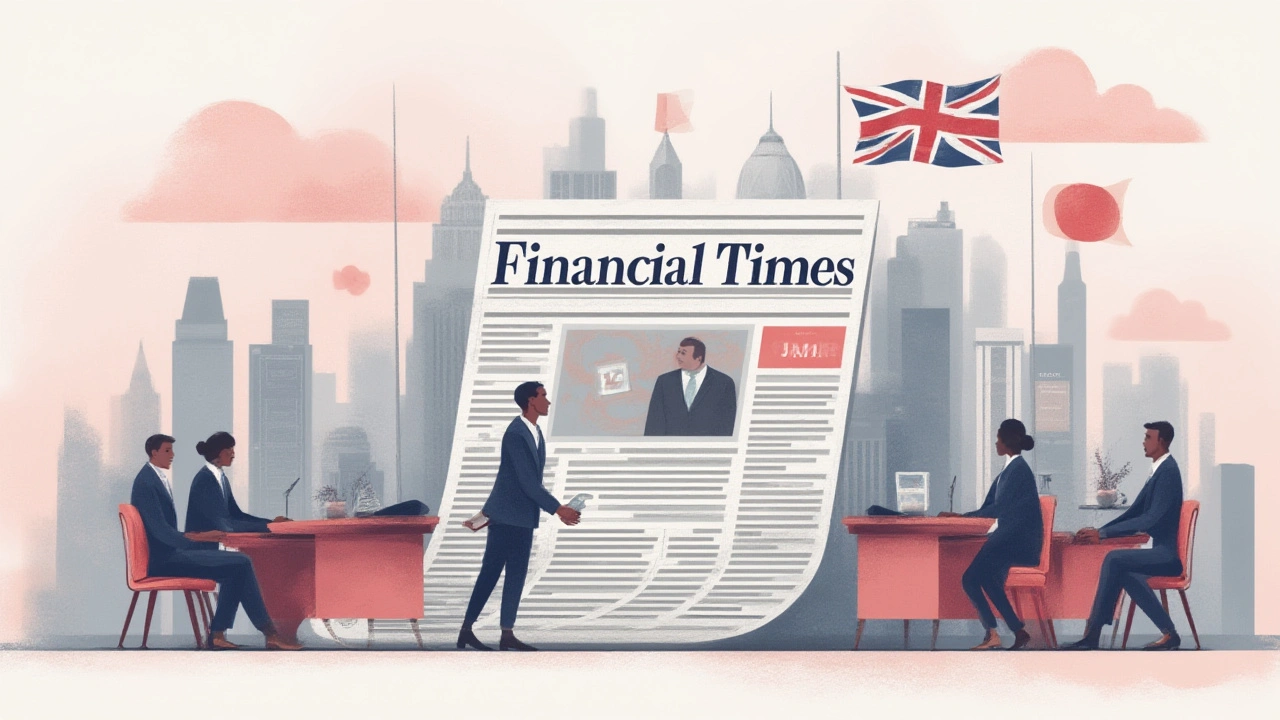
Picture this: Brits debating over their morning coffee about the “FT” being too left, too right, or perfectly balanced. Everyone has an opinion, but not many bother digging past headlines. The Financial Times (FT) is one of Britain’s oldest financial publications, trusted by City insiders, politicians, business leaders, and anyone keen on market gossip. Yet, its political leanings spark lively arguments from MPs to taxi drivers. Let’s get honest—what’s the real story behind the FT’s reputation?
What Drives the FT? Ownership, History, and Editorial Influences
To understand the FT’s supposed “leftness,” you need to look at who runs the show and what the paper’s history says about its DNA. Founded in 1888, the FT began as a market report for London’s finance crowd, not exactly a breeding ground for socialist firebrands. Through most of its life, it’s been associated with business reporting, economics, and highbrow commentary—not with radical lefty politics.
The FT was historically owned by Pearson PLC, a giant in media and education, until 2015. That’s when Nikkei, a massive Japanese publishing company, bought it for £844 million. Some suspected this could sway editorial slants, but Nikkei promised “editorial independence” and so far there’s no smoking gun to say otherwise. An interesting fact: Nikkei also has a reputation for understated, fact-heavy journalism—nothing too shouty or propagandistic.
Day to day, the FT newsroom operates mostly out of London, with worldwide bureaus chiming in. Its editors are usually Oxford or Cambridge graduates with years in financial reporting, not activists or political influencers. The paper takes its independence seriously—awkward for owners who might want to push an agenda.
Worth a mention: In a recent survey done by YouGov (2023), only 14% of Brits described the FT as “left-wing,” while 37% called it “centrist” and 13% thought it was “right-leaning.” The rest weren’t sure or didn’t care. This split in perception hints at a paper that resists easy labelling, at least in the public eye.
The FT’s Editorial Stance: Words, Endorsements, and Controversies
Here’s where things get juicy. Editorial stance means more than just one-off opinions—it’s the sum of leader columns, endorsements at election time, and what types of columnists are hired. The FT’s main focus has always been economic policy, global trade, and business regulation. That doesn’t scream left-wing in itself.
But, if you check their recent endorsements, things get a bit layered. The Financial Times supported Labour’s Tony Blair in the 1997, 2001, and 2005 elections. Blair, of course, was Labour in name but famously moved the party to the centre—some say to the right—making it more business-friendly. The FT’s support came at a time when the City of London was booming and Labour was courting big finance. Hardly the support of a traditional “lefty” paper.
Fast-forward to 2010 and the FT switched its endorsement to the Conservatives, led by David Cameron, arguing for fiscal discipline and market reforms. In 2015, it backed the Tories again, underlining the need for economic recovery. In 2019, it gave perhaps its most nuanced endorsement, supporting “a vote against Boris Johnson’s Conservatives” without going fully behind Corbyn’s Labour, instead suggesting a Liberal Democrat vote in many seats. If you’re keeping score, that’s not wild partisanship either way.
The FT’s opinion pages often dive deep on capitalism, globalisation, and market solutions. At the same time, its writers have been tough on nativism, Brexit, and Trump-era populism. You’ll find voices calling for green investments and corporate responsibility—but rarely an outright push for state ownership or hard-left policies. The telos is “liberal centrist”—not to be confused with “leftwing” in the hardcore, trade-unionist sense.
Columnists like Martin Wolf are respected worldwide for nuanced takes. Wolf, for example, is hardest on inequality when it threatens market stability but doesn’t shy away from defending capitalism. Janan Ganesh pokes holes in both left and right dogmas. Gillian Tett explores anthropology to explain business moves—far more interested in why people act the way they do than picking sides for tribal reasons.

Comparing the FT to Other Major British Newspapers
Let’s see how the FT stacks up beside its peers. In the UK, newspapers wear their politics on their sleeves—think The Guardian for the liberal left, The Telegraph and The Times for varying shades of right. The Daily Mail is loved by the Tory grassroots and loathed by Corbynistas. The Sun is populist through and through.
If you dig into reader opinion data from Ofcom (May 2024), The Guardian was labelled as left or liberal by 68% of readers; The Times as centre-right by 58%. For the FT, it’s muddier waters—the split between left, centre, and right is way more even.
The FT’s editorial language is more reserved than most rivals; it doesn’t blare out “Labour propaganda” like the Mirror or flex its “pro-business” muscle as shamelessly as the Telegraph. Its European coverage, post-Brexit, leans pro-market but also points out Brexit’s damaging costs—again, not fitting party lines perfectly.
On the subject of social issues—like immigration, climate change, or diversity—the FT tends to favour globalisation and open markets (which triggers traditionalists) but frames these things in terms of long-term business growth. Compare that to The Guardian, which spotlights social justice and activism, or to the Daily Mail, which often rails against immigration and perceived “woke” culture.
For readers, this can be confusing. The FT’s slant feels leftish to some, especially when it criticises Brexit or Trump, but to old-school lefties it’s practically free-market orthodoxy. It’s this blend—economically liberal, socially open, but not radical—that lands it in a political no man’s land. Here’s a snapshot of recent editorial endorsements:
| Newspaper | 2024 General Election Endorsement |
|---|---|
| Financial Times | Liberal Democrats, Anti-Johnson |
| The Guardian | Labour |
| The Times | Conservative |
| The Daily Telegraph | Conservative |
| The Mirror | Labour |
This tells you all you need to know about where the FT sits in the UK press landscape—not easy to pigeonhole.
Media Bias Ratings, Reader Perception, and Practical Impacts
How do outside analysts rank the FT? Let’s look at a couple of known tools. AllSides, a US-based media bias tracker, currently places the FT in the “centre” column, while Media Bias/Fact Check gives it a “least biased” badge and points to its strong sourcing and factual checks. These aren’t wild-eyed radicals—AllSides asks actual readers, not just academics, and Media Bias/Fact Check scours corrections and factual errors.
The FT’s audience is a bit niche compared to mass-market tabloids. Its typical reader is highly educated, urban, likely in finance, law, or academia. It’s got more non-UK readers than any other British paper—a third of its subscribers are from the US, where the paper sells itself as a window into “responsible British capitalism.” So if you find FT stories written in a cool-headed style, that’s almost by design. The reporting aims to inform more than inflame.
But even a cool head doesn’t make a paper immune to bias. The FT’s pages reflect clear priorities for free markets, internationalism, and open trade—values that can feel “left” to hardline Brexit supporters or “right” to people on the socialist left. That makes the FT a mirror: your own political leanings can shape how you read its news. If you’re a City banker, an FT leader might look too critical of big business. If you’re a Momentum supporter, talking up the European Single Market sounds like neoliberalism, not radical change.
Practical tip if you’re trying to “read between the lines”: follow the FT’s election coverage and pay attention to their leader columns. The news pieces are usually straightforward, but the editorials—especially around tax policy, climate commitments, and foreign affairs—show where the paper stands. Readers who want to cross-check should read the same stories in The Guardian, The Times, and BBC, noting differences in headline, emphasis, and sources quoted.
The Financial Times isn’t shy about its point of view, but you’re unlikely to find clear, unambiguous partisanship. Its bias, such as it is, lines up with centrist liberal values most of the time—pro-market, pro-globalisation, sometimes sharply critical of “populist” politics (left or right). With British politics getting more tribal by the year, the FT might still have the last laugh by refusing to pick a tribe at all.